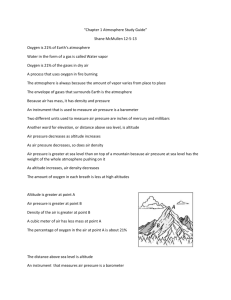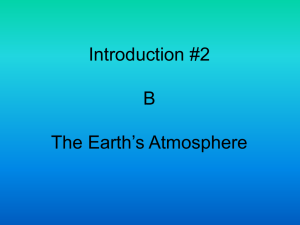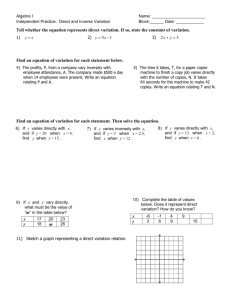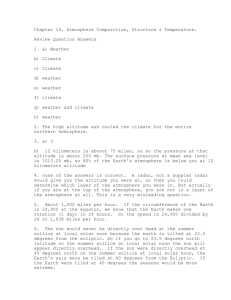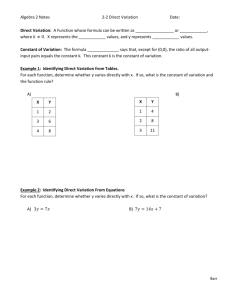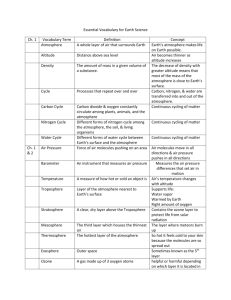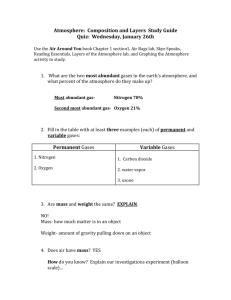AE 2350 Lecture #4
advertisement
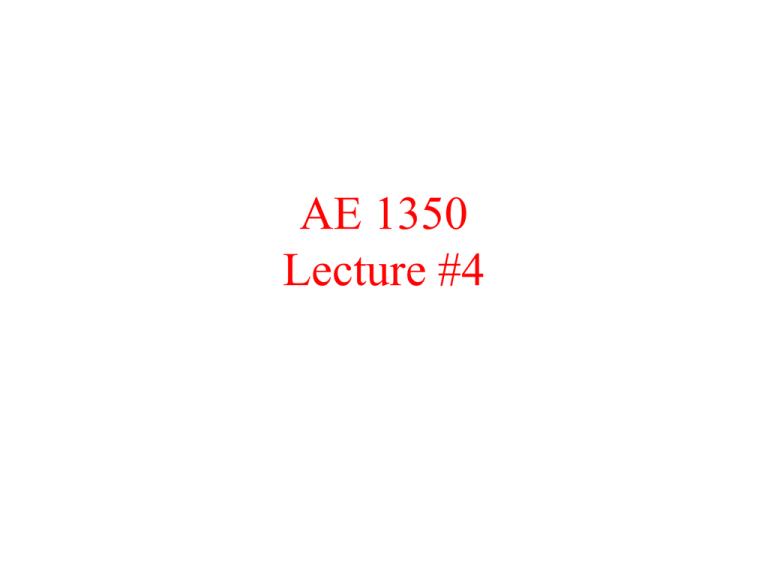
AE 1350 Lecture #4 PREVIOUSLY COVERED TOPICS • • • • • • Preliminary Thoughts on Aerospace Design Specifications (“Specs”) and Standards System Integration Forces acting on an Aircraft The Nature of Aerodynamic Forces Lift and Drag Coefficients TOPICS TO BE COVERED • Why should we study properties of atmosphere? • Ideal Gas Law • Variation of Temperature with Altitude • Variation of Pressure with Altitude • Variation of Density with Altitude • Tables of Standard Atmosphere Why should we study Atmospheric Properties • Engineers design flight vehicles, turbine engines and rockets that will operate at various altitudes. • They can not design these unless the atmospheric characteristics are not known. C L L 1 • For example, from last lecture, rV2 S 2 • We can not design a vehicle that will operate satisfactorily and generate the required lift coefficient CL until we know the density of the atmosphere, r. What is a standard atmosphere? • Weather conditions vary around the globe, from day to day. • Taking all these variations into design is impractical. • A standard atmosphere is therefore defined, that relates fight tests, wind tunnel tests and general airplane design to a common reference. • This common reference is called a “standard” atmosphere. International Standard Atmosphere Standard Sea Level Conditions Pressure 101325 Pa 2116.7 lbf/ft2 Density 1,225 Kg/m3 0.002378 slug/ft3 Temperature 15 oC or 288 K 59 oF or 518.4 oR Ideal Gas Law or Equation of State • Most gases satisfy the following relationship between density, temperature and pressure: • p = rRT – – – – – p = Pressure (in lb/ft2 or N/m2) r = “Rho” , density (in slugs/ft3 or kg/m3) T = Temperature (in Degrees R or degrees K) R = Gas Constant, varies from one gas to another. Equals 287.1 J/Kg/K or 1715.7 ft lbf/slug/oR for air Speed of Sound • From thermodynamics, and compressible flow theory you will study later in your career, sound travels at the following speed: • a gRT • where, – a = speed of Sound (m/s or ft/s) g = Ratio of Specific Heats = 1.4 – R = Gas Constant – T = temperature (in degrees K or degrees R) Temperature vs. Altitude 90 km 79 km 165.66 K Altitude, km 53 km 47 km, T= 282.66 K 25 km 11km 216.66K Stratosphere Troposphere 288.16 K Temperature, degrees K Pressure varies with Height The bottom layers have to carry more weight than those at the top Consider a Column of Air of Height dh Its area of cross section is A Let dp be the change in pressure between top and the bottom Pressure at the top = (p+dp) dh Pressure at the bottom = p Forces acting on this Column of Air Force = Pressure times Area = (p+dp)A dh Weight of air= r g A dh Force = p A Force Balance Force = (p+dp)A Downward directed force= Upward force (p+dp)A + r g A dh = pA r gA dh Simplify: dp = - r g dh Force = p A Variation of p with T dp = - r g dh Use Ideal Gas Law (also called Equation of State): p=rRT r = p/(RT) dp = - p / (RT) g dh dp/p = - g/(RT) dh Equation 1 This equation holds both in regions where temperature varies, and in regions where temperature is constant. Variation of p with T in Regions where T varies linearly with height From the previous slide, dp/p = - g/(RT) dh Equation 1 Because T is a discontinuous function of h (i.e. has breaks in its shape), we can not integrate the above equation for the entire atmosphere. We will have to do it one region at a time. In the regions (troposphere, stratosphere), T varies with h linearly. h Let us assume T = T1 +a (h-h1) The slope ‘a’ is called a Lapse Rate. h=h1 T=T1 Variation of p with T when T varies linearly (Continued..) From previous slide, An infinitesimal change in Temperature T = T1 +a (h-h1) dT = a dh Use this in equation 1 : dp/p = - g/(RT) dh We get: dp/p = -g/(aR)dT/T Integrate. Use integral of dx/x = log x. Log p = -(g/aR) log T + C Equation 2 where C is a constant of integration. Somewhere on the region, let h = h1 , p=p1 and T = T1 Log p1 = -(g/aR) log T1 + C Equation 3 Variation of p with T when T varies linearly (Continued..) Subtract equation (3) from Equation (2): log p - log p1 = - g/(aR) [log T - log T1] log (p/p1) = - g / (aR) log ( T/T1) Use m log x = log (xm) log g aR T p log T1 p1 p T p1 T1 g aR Variation of r with T when T varies linearly From the previous slide, in regions where temperature varies linearly, we get: p T p1 T1 g aR Using p = rRT and p1 = r1RT1, we can show that density varies as: r T r1 T1 g 1 aR Variation of p with altitude h in regions where T is constant In some regions, for example between 11 km and 25 km, the temperature of standard atmosphere is constant. How can we find the variation of p with h in this region? We start again with equation 1. dp/p = - g/(RT) dh Integrate: log p = - g/(RT) h + C Equation 1 Variation of p with altitude h in regions where T is constant (Continued..) From the previous slide, in these regions p varies with h as: log p = -g /(RT) h + C At some height h1, we assume p is known and his given by p1. Log p1 = - g/(RT) h1 + C Subtract the above two relations from one another: log (p/p1) = -g/(RT) (h-h1) Or, g h h1 p RT e p1 Concluding Remarks • Variation of temperature, density and pressure with altitude can be computed for a standard atmosphere. • These properties may be tabulated. • Short programs called applets exist on the world wide web for computing atmospheric properties. • Study worked out examples to be done in the class.
